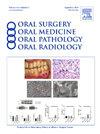头颈部尤文氏肉瘤3例病理报告
IF 1.9
3区 医学
Q2 DENTISTRY, ORAL SURGERY & MEDICINE
Oral Surgery Oral Medicine Oral Pathology Oral Radiology
Pub Date : 2025-07-21
DOI:10.1016/j.oooo.2025.04.050
引用次数: 0
摘要
尤因肉瘤是一种高度侵袭性的骨骼和软组织恶性肿瘤,主要影响儿童和年轻人的长骨。约85%的尤文氏肉瘤存在染色体易位t(11;22),产生特征性的致癌融合基因EWSR1::FLI1。虽然头颈部尤文氏肉瘤是罕见的,只有少数骨骼外的病例被报道,但这些肉瘤仍然具有通常的分子、显微镜和免疫表型特征。本文报告3例发生于71岁男性的上颌骨、18岁女性的下颌骨和32岁男性的口腔底。显微镜下,肿瘤由单一形态的小圆形蓝色细胞组成,细胞边界不清,少量苍白的细胞质,圆形至卵形的泡状细胞核,染色质精细分散。免疫组化显示肿瘤细胞中弥漫性和强膜性CD99反应性和NKX2.2核阳性。有183例报告的甲状腺肿病例,平均诊断年龄为25岁。最常见的受累部位是颅骨和面部(包括上颌骨)(40%)、软组织(30%)和下颌骨(9%)。这种情况并不常见,尤其是在非儿童人群中,但对于由未分化的小圆形蓝色细胞组成的肿瘤,在鉴别诊断中应予以考虑。其他具有相似组织学的肿瘤包括横纹肌肉瘤、淋巴瘤、神经内分泌肿瘤、原发性和转移性肿瘤以及BCOR和cic重排肉瘤等。CD99和NKX2.2免疫组化和分子研究有助于区分这类肿瘤。本文章由计算机程序翻译,如有差异,请以英文原文为准。
Ewing sarcoma of the head and neck: a histopathologic report of 3 cases
Ewing sarcoma is a highly aggressive malignancy of bone and soft tissues that primarily affects the long bones of children and young adults. Approximately 85% of Ewing sarcomas harbor the chromosomal translocation t(11;22), which produces the characteristic oncogenic fusion gene EWSR1::FLI1. Although head and neck Ewing sarcomas (HNESs) are rare and only few extraskeletal cases have been reported, these still present with the usual molecular, microscopic, and immunophenotypic features. This paper reports 3 cases of HNESs in the maxilla of a 71-year-old male, mandible of an 18-year-old female, and floor of the mouth of a 32-year-old male. Microscopically, the tumors consist of a monomorphic population of small round blue cells with indistinct cell borders, scant amounts of pale cytoplasm, and round to ovoid vesicular nuclei with finely dispersed chromatin. Immunohistochemistry reveals diffuse and strong membranous CD99 reactivity and nuclear positivity for NKX2.2 in the tumor cells. There have been 183 reported cases of HNESs, with the mean age at diagnosis of 25 years. The most commonly affected sites are bones of the skull and face (including maxilla) (40%), soft tissues (30%), and mandible (9%). HNESs are uncommon, especially in nonpediatric population but should be considered in the differential diagnosis for tumors composed of undifferentiated small round blue cells. Other tumors that share similar histology include rhabdomyosarcomas, lymphomas, neuroendocrine tumors, primary and metastatic, and BCOR- and CIC-rearranged sarcomas to name a few. Immunohistochemistry with CD99 and NKX2.2 and molecular studies help to differentiate between such tumors.
求助全文
通过发布文献求助,成功后即可免费获取论文全文。
去求助
来源期刊

Oral Surgery Oral Medicine Oral Pathology Oral Radiology
DENTISTRY, ORAL SURGERY & MEDICINE-
CiteScore
3.80
自引率
6.90%
发文量
1217
审稿时长
2-4 weeks
期刊介绍:
Oral Surgery, Oral Medicine, Oral Pathology and Oral Radiology is required reading for anyone in the fields of oral surgery, oral medicine, oral pathology, oral radiology or advanced general practice dentistry. It is the only major dental journal that provides a practical and complete overview of the medical and surgical techniques of dental practice in four areas. Topics covered include such current issues as dental implants, treatment of HIV-infected patients, and evaluation and treatment of TMJ disorders. The official publication for nine societies, the Journal is recommended for initial purchase in the Brandon Hill study, Selected List of Books and Journals for the Small Medical Library.
 求助内容:
求助内容: 应助结果提醒方式:
应助结果提醒方式:


